LEGO STEM – Happy Traveler
7 Classes – Grades 3 – 5
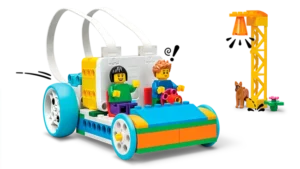
Join our Hands-On LEGO SPIKE™ Essential: Happy Traveler Class!
Get ready to embark on an exciting journey of creativity, coding, and exploration with our Happy Traveler class—part of the LEGO® Education SPIKE™ Essential series!
This hands-on class lets kids dive into fun, story-based adventures where they’ll design, build, and program travel-themed creations like scooters, trains, and more.
Along the way, they’ll learn the basics of robotics, teamwork, and problem-solving—all while having a blast with LEGO bricks and motors. Whether your child is new to STEM or already a young inventor, this is the perfect place to start their learning adventure!
✅ Perfect for ages 6–10
✅ Weekly 40-minute sessions
✅ Includes progressive lessons in building, coding, and teamwork
✅ Great for beginners.
✅ Small Classes – 4 kids max per class.
LESSON 1
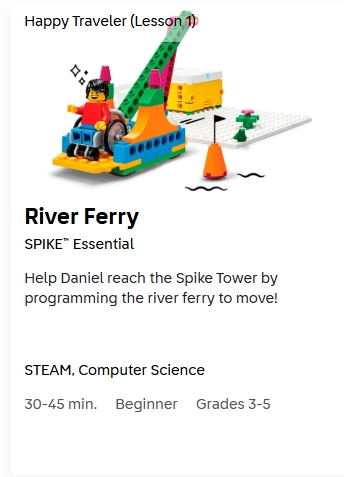
Key Objectives
Lesson 1 River Ferry
Students will program a ferry to transport characters across a river, developing sequencing skills and understanding of basic programming concepts.
Educational Standards
Lesson 1 River Ferry
Educational Standards
-
CSTA 1B-AP-10: Create programs that include sequences, events, loops, and conditionals.
-
NGSS 3-5-ETS1-1: Define a simple design problem reflecting a need or a want that includes specified criteria for success and constraints on materials, time, or cost.
-
ISTE 1.4d: Students exhibit a tolerance for ambiguity, perseverance, and the capacity to work with open-ended problems.
-
CCSS.ELA-LITERACY.SL.3.1: Engage effectively in a range of collaborative discussions with diverse partners.
LESSON 2
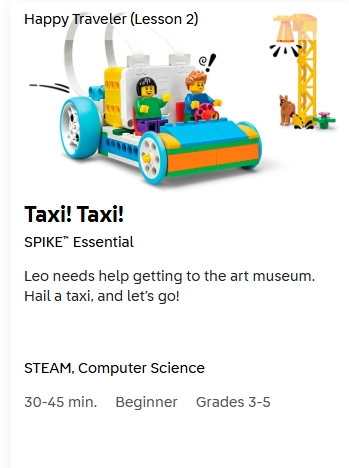
Key Objectives
Lesson 2 Taxi! Taxi!
Students will design and program a taxi to follow a specific route, enhancing their debugging and problem-solving skills.
Educational Standards
Lesson 2 Taxi! Taxi!
Educational Standards
-
CSTA 1B-AP-11: Decompose problems into smaller, manageable subproblems to facilitate the program development process.
-
NGSS 3-5-ETS1-2: Generate and compare multiple possible solutions to a problem based on how well each is likely to meet the criteria and constraints of the problem.
-
ISTE 1.5b: Students collect data or identify relevant data sets, use digital tools to analyze them, and represent data in various ways to facilitate problem-solving and decision-making.
-
CCSS.ELA-LITERACY.W.3.3: Write narratives to develop real or imagined experiences or events using effective technique, descriptive details, and clear event sequences.
LESSON 3
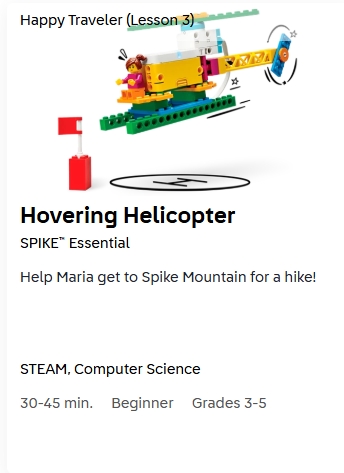
Key Objectives
Lesson 3 Hovering Helicopter
Students will build and program a helicopter that responds to tilting, exploring sensor integration and conditional programming.
Educational Standards
Lesson 3 Hovering Helicopter
Educational Standards
-
CSTA 1B-AP-17: Describe choices made during program development using code comments, presentations, and demonstrations.
-
NGSS 3-5-ETS1-3: Plan and carry out fair tests in which variables are controlled and failure points are considered to identify aspects of a model or prototype that can be improved.
-
ISTE 1.5b: Students collect data or identify relevant data sets, use digital tools to analyze them, and represent data in various ways to facilitate problem-solving and decision-making.
-
CCSS.ELA-LITERACY.SL.3.4: Report on a topic or text, tell a story, or recount an experience with appropriate facts and relevant, descriptive details, speaking clearly at an understandable pace.
LESSON 4
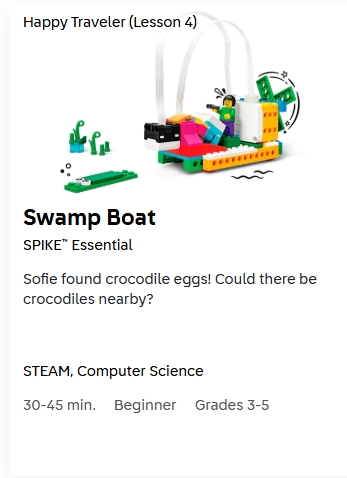
Key Objectives
Lesson 4 Swamp Boat
Students will create a boat that detects proximity to crocodiles, focusing on sensor use and program modification.
Educational Standards
Lesson 4 Swamp Boat
Educational Standards
-
CSTA 1B-AP-12: Modify, remix, or incorporate portions of an existing program into one’s own work, to develop something new or add more advanced features.
-
NGSS 3-5-ETS1-2: Generate and compare multiple possible solutions to a problem based on how well each is likely to meet the criteria and constraints of the problem.
-
ISTE 1.4d: Students exhibit a tolerance for ambiguity, perseverance, and the capacity to work with open-ended problems.
-
CCSS.MATH.CONTENT.3.MD.B.3: Draw a scaled picture graph and a scaled bar graph to represent a data set with several categories.
LESSON 5
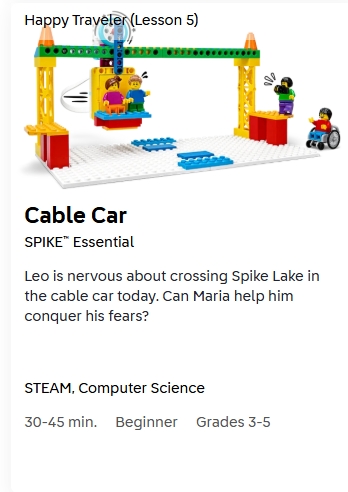
Key Objectives
Lesson 5 Cable Car
Students will program a cable car to transport characters across a lake, emphasizing the use of loops and sequences.
Educational Standards
Lesson 5 Cable Car
Educational Standards
-
CSTA 1B-AP-10: Create programs that include sequences, events, loops, and conditionals.
-
NGSS 3-5-ETS1-2: Generate and compare multiple possible solutions to a problem based on how well each is likely to meet the criteria and constraints of the problem.
-
ISTE 1.5d: Students understand the fundamental concepts of technology operations, demonstrate the ability to choose, use, and troubleshoot current technologies.
-
CCSS.ELA-LITERACY.W.3.3: Write narratives to develop real or imagined experiences or events using effective technique, descriptive details, and clear event sequences.
LESSON 6
Key Objectives
Lesson 6 Big Bus
Students will design and program a bus to reach a stadium, integrating multiple programming concepts and problem-solving strategies.
Educational Standards
Lesson 6 Big Bus
Educational Standards
-
CSTA 1B-AP-11: Decompose problems into smaller, manageable subproblems to facilitate the program development process.
-
NGSS 3-5-ETS1-3: Plan and carry out fair tests in which variables are controlled and failure points are considered to identify aspects of a model or prototype that can be improved.
-
ISTE 1.4d: Students exhibit a tolerance for ambiguity, perseverance, and the capacity to work with open-ended problems.
-
CCSS.ELA-LITERACY.SL.3.1: Engage effectively in a range of collaborative discussions with diverse partners.
LESSON 7
Key Objectives
Lesson 7 Get Around Town
Students will apply their accumulated knowledge to help characters navigate to a castle, reinforcing and integrating previous concepts.
Educational Standards
Lesson 7 Get Around Town
Educational Standards
-
CSTA 1B-AP-17: Describe choices made during program development using code comments, presentations, and demonstrations.
-
NGSS 3-5-ETS1-3: Plan and carry out fair tests in which variables are controlled and failure points are considered to identify aspects of a model or prototype that can be improved.
-
ISTE 1.5b: Students collect data or identify relevant data sets, use digital tools to analyze them, and represent data in various ways to facilitate problem-solving and decision-making.
-
CCSS.ELA-LITERACY.SL.3.4: Report on a topic or text, tell a story, or recount an experience with appropriate facts and relevant, descriptive details, speaking clearly at an understandable pace.
In this interactive robotics session, students embark on an exciting journey with LEGO Spike Prime, exploring the fundamentals of robotic movement and sensors through the lens of travel and transportation. Participants will design, build, and program autonomous vehicles capable of navigating custom-built travel routes, simulating real-world scenarios. This hands-on lesson promotes creativity, problem-solving, teamwork, and coding skills, enabling young innovators to experience firsthand how technology enhances modern transportation.
Key Learning Objectives:
-
Design and construct robotic vehicles using LEGO Spike Prime components.
-
Program vehicles to navigate and respond to environmental inputs.
-
Explore concepts related to movement, sensors, and autonomous navigation.
-
Foster collaboration and communication skills through teamwork.
Ideal for beginners and intermediate students, this lesson offers an engaging introduction to robotics and coding, ensuring each participant leaves as a confident “Happy Traveler” in the exciting world of robotics!
Paid in Full
$35 a class x 7 classes
- Flexible attendance: attend at your convenience (twice weekly recommended)
- Secure project storage (up to 30 days between sessions)
- Priority re-entry and progress retention
- 10% discount on each additional sibling enrolled simultaneously.
Paid in Two
$42 a class x 7 classes
- Flexible attendance: attend at your convenience (twice weekly recommended)
- Secure project storage (up to 15 days between sessions)
- Priority re-entry and progress retention
- 10% discount on each additional sibling enrolled simultaneously.
Competitor Comparison (Local Competitors):
| Competitor | Average Price per Session | Hands-On Robotics | Personalized Storage & Flexible Scheduling |
|---|---|---|---|
| Kumon | $35 – $45 | ❌ | ❌ |
| Mathnasium | $40 – $50 | ❌ | ❌ |
| iCode / Code Ninjas | $35 – $50 | ✅ (basic coding) | Limited |
| Our Program | $35-$42 | ✅ (advanced robotics) | ✅ (personalized & flexible) |
We understand schedules can be challenging, so our LEGO Spike Prime “Happy Travelers” program is designed with flexibility in mind. Your child can attend sessions twice weekly, and we’ll always pick up exactly where they left off during their next visit.
-
Personalized Progress:
Each student is assigned a dedicated cubby where we safely store their robot and project progress between classes. -
Absence & Progress Retention:
If your child needs to miss a session (or even a few sessions), that’s completely fine. We’ll preserve their robot and project for up to 30 consecutive days from their last attended session. -
Important Note:
After 30 consecutive days of absence, we may need to repurpose your child’s robot for use by another participant. In such cases, their project progress may not be retained, and they may need to restart the build and programming process upon returning.
We encourage consistent attendance to ensure optimal learning and project continuity.
Lesson-Specific Standards Mapping
Each lesson within the Happy Traveler Challenge is designed to address specific Education standards:
By participating in these lessons, students not only gain practical robotics experience but also develop competencies outlined in national educational standards, ensuring a comprehensive STEM learning experience.
CSTA = Computer Science Teachers Association
CCSS = Common Core State Standards
ISTE = International Society for Technology in Education
NGSS = Next Generation Science Standards
Robotics Camp Safety Guidelines and Mandatory Requirements
Ensuring a Safe and Enjoyable Experience At Florida Man’s Toys Robotics Camp, the safety and well-being of our students are our highest priority. To maintain a secure, respectful, and productive learning environment, please carefully review and adhere to the following mandatory safety guidelines:
Parent/Guardian Supervision
- Parents or guardians must remain on mall premises during the entire duration of each robotics session. This requirement ensures prompt accessibility and quick assistance if needed.
Safe Handling of Components
- Students must handle all robotics components carefully, using both hands at all times.
- Small robotics parts pose potential choking hazards. Students must not put any components into their mouths.
Behavioral Expectations
- All students are required to follow the instructor’s instructions promptly and carefully. This ensures their safety and the safety of other participants.
- Disruptive or disrespectful behavior will not be tolerated. This includes, but is not limited to, inappropriate language, aggressive actions, and disregarding safety instructions.
- Cellphone use is prohibited during the live lesson. Students are expected to keep cellphones on silent.\
- Throwing or mishandling robotics components is strictly prohibited and may result in immediate removal from the camp without refund.
- Hitting, Spitting, Bitting or Throwing any object at other students’ staff or parents is not allowed, will be grounds for immediate removal from the camp.
Special Considerations
- If your child requires additional support or accommodations to adhere safely and comfortably to these guidelines, please contact us in advance. Our team strives to provide personalized attention and support but cannot offer one-on-one supervision at all times.
- Please carefully assess your child’s ability to adhere to these safety guidelines before enrollment.
Parents & Guardians
- One parent is allowed to be present inside the lab during lessons.
- Parents, please refrain from making or taking phone calls during the lessons.
- There are chairs and tables directly outside of our store inside the Mall if you do not wish to wait in class or if you have more than one person with you.
Compliance with these rules is mandatory and non-negotiable. Together, we can ensure a positive, educational, and safe experience for everyone involved.
Thank you for your cooperation and understanding in helping us create an enriching robotics learning environment!



